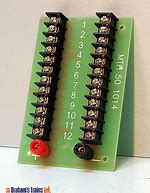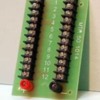We were all newbies at the beginning, so don't feel bad and no pressure. It's always good to ask questions.
IMHO, whether you use bus wires or terminal blocks is a matter of personal preference. Bus wires are just long wires (typically 14 gauge) from each output of your transformer (+ and -) that run underneath your layout and roughly mimicking the shape of your loop and come to an end back near your transformer without connecting to anything. You would then run feeder wires/power drops (16-18 gauge) spaced around your loop every few feet or so from the bus wires to a lock-on. The feeder wires connect to the bus wires using special connectors such as "suitcase" or T-type connectors. You would not want to wire from one lock-on to another. Using this method, power is transmitted to every part of the loop, so that there are no dead spots.
Assuming you have a terminal/distribution block similar to the one pictured below, the alternative method is to wire your transformer directly to the main red and black inputs on the terminal block (using 14 gauge wire) and then run paired 16-18 gauge wires from as many outputs on the terminal block as you need, to your lock-ons spaced around the loop. This method will also provide power to all parts of your layout.
In either case the feeder wires are typically run up from the bus wires or terminal block outputs through small holes drilled in the layout base.
These terminal blocks come in 12 and 24 output varieties based on the size of your layout.






